|
|
 |
|
Calanoida ( Order ) |
|
|
|
Metridinidae ( Family ) |
|
|
|
Gaussia ( Genus ) |
|
|
| |
Gaussia sewelli Saraswathy, 1973 (F,M) | |
| | | | | | | Syn.: | Metridia scotti : Sewell, 1913 (p.354);
Gaussia princeps : Sewell, 1932 (p.270, fig.F,M, Juv.); 1947 (p.173); Brodsky, 1950 (1967) (part., p.312, figs. Ind. Oc: F,M, non figs. NP: F,M, Rem.); ? Tanaka & Omori, 1967 (p.251); Grice & Hulseman, 1967; Saraswathy, 1971 | | | | Ref.: | | | Saraswathy, 1973 a (p.192, figs.F,M); Björnberg & Campaner, 1988 (p.351, Rem.); Padmavati & al., 1998 (p.347); Soh & al., 1998 (p.172, figs.F,M, fig.7: carte, Rem.); Suarez-Morales, 2007 (40, tabl.2, 3); Stephen ( Data sheets of NIO, Kochi, India (on line, Diagnostic characteristics, figs.F,M). | 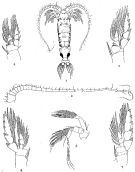 Issued from : R.B.S. Sewell in Mem. Indian Mus., 1932, X (continued). [P;.V]. As Gaussia princeps. Female (from N Indian Ocean): 1, habitus (dorsal); 2, A1; 3, A2; 4, P1; 5, P2; 6, P3; 7, P4.
|
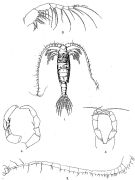 Issued from : R.B.S. Sewell in Mem. Indian Mus., 1932, X (continued). [P;.VI]. As Gaussia princeps. Male: 1, habitus (dorsal); 2, right A1; 4, P5. Female: 3, Mxp; 4, P5; 5,
|
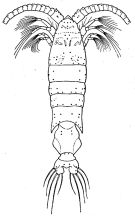 Issued from : R.B.S. Sewell in Mem. Indian Mus., 1932, X (continued). [p.271, Fig.92]. As Gaussia princeps. Female (from Laccadive Sea): habitus, dorsal (arrangement of the cutaneous pores).
|
 Issued from : R.B.S. Sewell in Mem. Indian Mus., 1932, X (continued). [p.276, Fig.93, a]. As Gaussia princeps. Female: a, urosome (lateral left side).
|
 issued from : H.Y. Soh, S. Ohtsuka, H. Imabayashi & S. Sawamoto inSpecies Diversity, 1998, 3. [p.178, Fig.5 G]. Female (from the Indian Ocean): G, distal seta on 3rd exopodal segment of rigt P5.
|
 issued from : H.Y. Soh, S. Ohtsuka, H. Imabayashi & S. Sawamoto inSpecies Diversity, 1998, 3. [p.180, Fig.6 H]. Male (from the Indian Ocean): H, P5 (posterior; distal two exopodal segments of right leg torted).
|
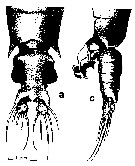 issued from : R. Stephen, 2007 [Data sheets of NIO, Kochi, India (on line)]. After M. Saraswathy, 1973. Female (from Arabian Sea and Bay of Bengal): a, last thoracic segment and urosome (dorsal). Male: c, last thoracic segment and urosome (lateral). Nota: Posterolateral corners of last thoracic segment: Backwardly directed hardly divergent spines. Genital segment: Symmetrical lateral inflations. Caudal rami distal protuberance: Barely evident.
|
 issued from : M. Saraswathy in Handbook to the Intern. zoopl. Coll., Cochin-18, Kerala State, India, 1973. [p.193, Figs.4, 5]. Female (from Indian Ocean): 4, P5. Male: 5, P5.
|
 issued from : M. Saraswathy & J.M. Bradford in N. Z. Jl mar. freshw. Res., 1980, 14 (1). [p.80, Fig.1]. Male: right A1. Positions of various integumental structures indicated. A, ventral view; B, dorsal view of proximal part; A, aesthetasc; P, pore; Pr, pits with radiating ridges; Se, seta; Sq, suat appendage.
|
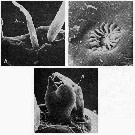 issued from : M. Saraswathy & J.M. Bradford in N. Z. Jl mar. freshw. Res., 1980, 14 (1). [p.81, Fig.2]. SEM details of male right A1: A, segment 16 showing aesthetasc (A) and associated pit with radiating pores (x825); B, pit with radiating ridges (x4650); C, segment 11 showing the squat appendage (x860). Nota: Pits with radiating ridges: These are on the ventral surface, always at the base of an aesthetasc, in the female and the male. The floor of the pit appears to be raised towards the centre and is almost covered in a radial pattern apparently by extensions of the surronding integuments. Squat appendage on male segment 11: This is on the anterodistal corner of segment 11 of the right A1 and ends in separate hemisperical and cone-shaped protuberances without pores or other external structures. It is apparently articulated with its segment and appears to be a modified seta judging from its position relative to the aesthetasc. This structure was found on all adult males of G. sewelli and G. scotti (= G. princeps).
| | | | | Compl. Ref.: | | | Madhupratap & Haridas, 1986 (p.105, tab.1); Kazmi, 2004 (p.228, as swelli, Rem.: p.232) | | | | NZ: | 1 + 1 doubtful | | |
|
Distribution map of Gaussia sewelli by geographical zones
|
| | | | | | 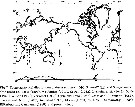 issued from : H.Y. Soh, S. Ohtsuka, H. Imabayashi & S. Sawamoto inSpecies Diversity, 1998, 3. [p.182, Fig.7]. issued from : H.Y. Soh, S. Ohtsuka, H. Imabayashi & S. Sawamoto inSpecies Diversity, 1998, 3. [p.182, Fig.7].
Zoogeographical distribution of Gaussia princeps, G. sewelli and G.asymmetrica |
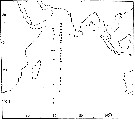 issued from : M. Saraswathy in Handbook to the Intern. zoopl. Coll., Cochin-18, Kerala State, India, 1973. [p.193]. issued from : M. Saraswathy in Handbook to the Intern. zoopl. Coll., Cochin-18, Kerala State, India, 1973. [p.193].
Localities from G. scotti (= G. princeps) (black circle) and G. sewelli (white circle) obtained. |
| | | | Loc: | | | N Indian (Arabian Sea, Bay of Bengal), ? Japan | | | | N: | 3 | | | | Lg.: | | | (44) F: 9,5-9; M: 9,5-8; (94) F: 9,9-9,4; M: 9,6-8,4; {F: 9,00-9,90; M: 8,00-9,60}
The mean female size is 9.450 mm (n = 4; SD = 0.3697), and the mean male size is 8.875 mm (n = 4; SD = 0.7974). The size ratio (male : female) is 0.94.. | | | | Rem.: | meso-bathypelagic.
A doubt subsists on the identification made by Tanaka & Omori (1967) if one admits G. sewelli.
See remarks in Gaussia princeps.
For Saraswathy (1973 a, p.193) the first record of the genus Gaussia from the Indian Ocean was that of Sewell (1913). There is an erroneous statement in Wolfenden (1911) that Gaussia was obtained in Gardiner's collection from the Indian Ocean. The drawings of Sewell (1932) are clear enough to recognize them as different of G. scotti (= Gaussia princeps) by several authors. | | | Last update : 13/02/2016 | |
|
|
 Any use of this site for a publication will be mentioned with the following reference : Any use of this site for a publication will be mentioned with the following reference :
Razouls C., Desreumaux N., Kouwenberg J. and de Bovée F., 2005-2025. - Biodiversity of Marine Planktonic Copepods (morphology, geographical distribution and biological data). Sorbonne University, CNRS. Available at http://copepodes.obs-banyuls.fr/en [Accessed December 04, 2025] © copyright 2005-2025 Sorbonne University, CNRS
|
|
 |
 |













